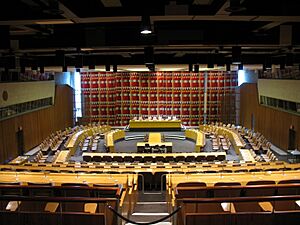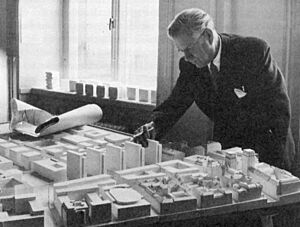Sven Markelius facts for kids

Sven Gottfrid Markelius (born October 25, 1889 – died February 24, 1972) was a famous Swedish architect. He was known for his modern designs. Markelius played a big part in planning the city of Stockholm after World War II. He helped create modern neighborhoods like Vällingby in the 1950s and Farsta in the 1960s.
Contents
Who was Sven Markelius?
Sven Markelius was born in Stockholm. He studied architecture at the Royal Institute of Technology and the Academy of Arts in Stockholm from 1910 to 1915. After his studies, he worked with other well-known architects.
He became very interested in how people lived and how cities were planned. In 1928, he helped start a group called CIAM. This group brought together architects from around the world who believed in modern design.
What is Functionalism?
Markelius was also involved in the Stockholm International Exhibition (1930). This event showed off new ideas in design, including a style called "Functionalism." Functionalism in architecture means that buildings should be designed mainly for their purpose and usefulness, not just for decoration. This idea became very popular in Sweden.
In 1931, Markelius helped write a book called "acceptera" (which means "accept" in Swedish). This book explained why modern design ideas were important for society.
The Collective House
One of Markelius's interesting projects was the Collective House in Stockholm, built in 1935. He worked with a Swedish reformer named Alva Myrdal on this project. This building had 57 apartments and shared spaces for everyone. It included things like childcare facilities and shared kitchens. The idea was to make daily life easier for families. Markelius himself lived in the Collective House for 30 years. He even helped fix things around the building to make sure it worked well for everyone. This showed how much he believed in creating good social housing.
Later Projects and Awards
Sven Markelius also designed many important public buildings. In 1932, he started working on the Concert Hall in Helsingborg. Later, in 1952, he was chosen by Sweden to help design the United Nations Secretariat Building in New York City. This was a very important job, showing his international recognition. Towards the end of his career, he focused more on planning entire cities.
Markelius received several awards for his work. He won the Howland Memorial Prize in 1949 and the Prince Eugen Medal in 1961. In 1962, he was given a Royal Gold Medal by the Royal Institute of British Architects. These awards recognized his great contributions to architecture and city planning.
Important Buildings and Plans
Here are some of the key projects Sven Markelius worked on:
- 1931 - Student Union at the Royal Institute of Technology, Stockholm (with Uno Åhrén)
- 1932 - Helsingborg Concert Hall (finished in 1934)
- 1933 - Villa Markelius, his own home in Stockholm
- 1935 - Stockholm Collective House
- 1937 - Villa Myrdal
- 1939 - Swedish pavilion at the 1939 New York World's Fair
- 1945 and later - City planning for the Redevelopment of Norrmalm, Stockholm
- 1952 - Interior design for the United Nations Economic and Social Council room, a gift from Sweden to the United Nations
- 1953 - Original city plan for Vällingby
- 1961-1966 - Sverigehuset (Sweden House) at Kungsträdgården
- 1962 - One of the five glass Hötorget buildings in Stockholm
Images for kids
See also
 In Spanish: Sven Markelius para niños
In Spanish: Sven Markelius para niños






